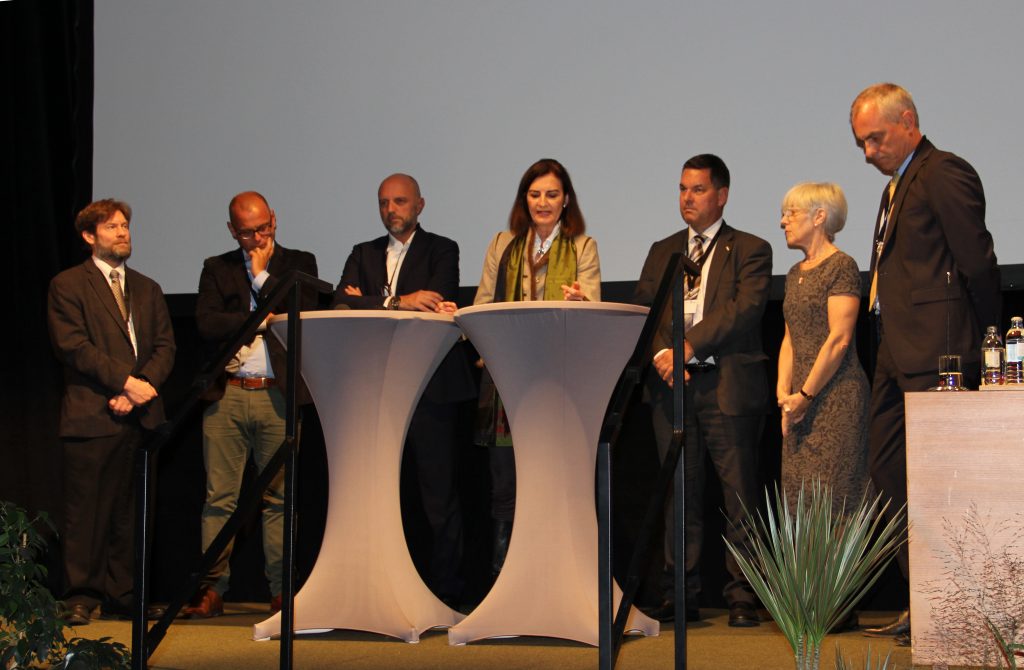The 56th Man-Made Fibers Congress (MFC) in Dornbirn, Austria, that took place from 13. – 15. September 2017 has become an outstanding success. The number of participants has significantly increased this year. Representatives from leading companies throughout the entire textile value chain from Fiber towards retail were involved in the presentations and panel discussions. Topics were fiber innovations, fibers, textiles and nonwovens for medical and hygiene, protective applications and sports and leasure wear.
Panel Discussion rounding up the session on fibers, textiles and nonwovens for protective applications

©IHOFMANN: Stanhope (TenCate), Henssen (DSM Dyneema), Berardi (Nilit), Hofmann (IHOFMANN), Spöcker (Lenzing FR), Orndoff (NASA), Zepf (PBI)
An US study from Global Market Insight Inc. shows why the topic Personal Protective Equipment (PPE) is so important. The study assumes that a lot more preventive measures will be taken to increase safety at the workplace. According to the study the worldwide market for PPE will grow to 67,7 billion US$ until 2023, with an annual average growth rate of seven percent.
The panel discussion on Thursday, the second day of the congress, was presented by Dr. Isa Hofmann, managing director of IHOFMANN. The title was: „The endless saga of ultra-light & ingenious performance features: What´s next?” Six representatives from different industries discussed how requirements of PPE have changed during the last years and will undergo further modifications in the future.
Participants of the panel discussion:
- Evelyne Orndoff, Principal Investigator IVA (Intravehicular Activity), NASA (USA):
She is involved in the development of protective gear for astronauts, an extreme application, since the environment in space is hostile to human life. Orndoff is currently doing research for adequate PPE for the planned manned Martian mission in 2030. Astronauts are facing a very high radiation in „deep space“, the suit has to cope with this. - Oliver Spöcker, Global Sales Director, Lenzing FR (AT):
Since the 1980ies wearability and comfort of professional clothing became a major focus point in research. Lenzing FR took account of those requirements by providing fibers, that supply ultimate comfort for any extreme situation. - Michael Stanhope, Global Vice President Innovation and Quality Assurance, TenCate (USA):
The focus is on new requirements for safety and wearability. TenCate is developing both, inherently flame retardant and coated FR materials. - Pierluigi Berardi, Vice President Global Marketing und R&D, Nilit (Israel, Italy):
Berardi explains Nilit´s answer with regards to the changes in retail and the challenges with the new generation of consumers. Clothing recently has to fullfill new requirements which means also new marketing and sales strategies are essential. The consumer shall gain immediate brand awareness. - Giovanni Henssen, Business Development Manager EMEA / Performance Apparel, DSM Dyneema (NL):
Cut-resistent protective equipment: “The greenest strength” / “stronger than steel”. Only 2-3% of Dyneema can double the lifetime of clothes. - Helmut Zepf, Vice President International Sales & Marketing, PBI Performance Products (USA/Germany):
PPE of firefighters is the main focus. Firefighters are experiencing various work-related diseases through contamination with toxic and harmful substances.
The future of PPE
All participants in the panel agreed: Also in the future there will be not an all-in-one solution suitable for every purpose. New material developments and combinations as well as processing technologies will fulfill the growing requirements for protective gear and provide at the same time utmost comfort. In a nutshell PPE will more and more fulfill the same requirements as leasure wear as far as aesthetics, design and comfort is concerned and of course observe the professional safety standards. The willingness to innovate is unanimously considered as the main challenge.
